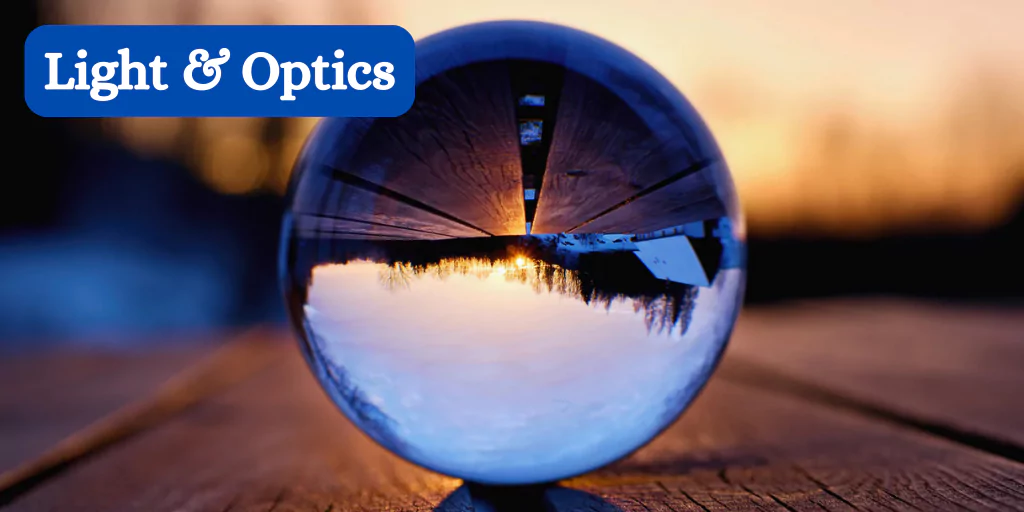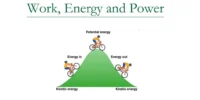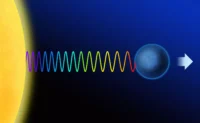Light & Optics are among the most fascinating areas of physics. Light allows us to see the world around us, while optics studies how it interacts with objects and surfaces. From the reflection in mirrors to the power of microscopes and telescopes, light & optics explain it all.
Reflection of Light

Reflection is the bouncing back of light when it strikes a smooth surface, such as a mirror.
Laws of Reflection:
- The angle of incidence is equal to the angle of reflection.
- The incident ray, the reflected ray, and the normal all lie in the same plane.
Examples in real life: mirrors, shiny surfaces, still water, and polished metals.
Lenses and Their Uses
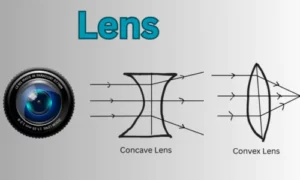
A lens is a transparent material (usually glass or plastic) that refracts light to converge or diverge rays.
- Convex Lens (Converging lens): Brings light rays together; used in magnifying glasses, cameras, microscopes, and telescopes.
- Concave Lens (Diverging lens): Spreads out light rays; used in spectacles for people with myopia (short-sightedness).
Lens Formula: 1/f = 1/v – 1/u
where f = focal length, v = image distance, and u = object distance.
Telescopes
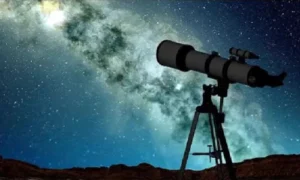
A telescope is an optical instrument used to observe distant objects, especially in astronomy.
- Refracting Telescope: Uses lenses to bend and focus light.
- Reflecting Telescope: Uses mirrors instead of lenses.
Application: studying planets, stars, and galaxies. Telescopes have opened the window to space exploration.
Microscopes

A microscope magnifies tiny objects that cannot be seen with the naked eye.
- Simple Microscope: Uses a single convex lens (like a magnifying glass).
- Compound Microscope: Uses two or more lenses to achieve higher magnification.
Application: biology, medicine, nanotechnology—helping us study cells, bacteria, and microscopic structures.
Refraction of Light: Principles, Uses & Phenomena
Have you ever noticed that a pencil bends when placed in a glass of water? Or why do stars appear to twinkle at night? These intriguing phenomena result from light refraction. Refraction is a fundamental concept in optics that describes how light behaves when it moves from one material to another.
What is Refraction of Light?
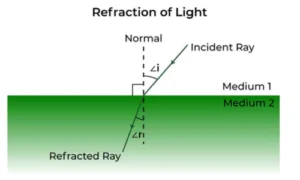
Refraction is the bending of light rays when they travel from one medium to another (for example, from air to water or glass). This bending occurs because the speed of light changes in different media.
- Light travels fastest in air (or vacuum).
- It slows down in denser media like water or glass.
Principles of Refraction
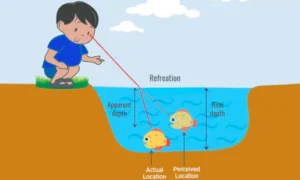
1. Change in Speed Causes Bending
- When light enters a denser medium (air → water), it slows down and bends towards the normal.
- When it moves to a rarer medium (water → air), it speeds up and bends away from the normal.
2. Laws of Refraction (Snell’s Law):
- The incident ray, the refracted ray, and the normal all lie in the same plane.
- The ratio of the sine of the angle of incidence to the sine of the angle of refraction is constant:
n1 sin θ1=n2 sin θ2
where n is the refractive index of the medium.
Everyday Examples of Refraction

- A straw or pencil appears bent in a glass of water.
- The twinkling of stars (light bends as it passes through layers of air).
- A pool appears shallower than its actual depth.
- The rainbow, formed due to the refraction and dispersion of light in water droplets.
Uses of Refraction
- Lenses in Glasses and Contact Lenses – Correcting vision problems like myopia (short-sightedness) and hypermetropia (long-sightedness).
- Cameras and Projectors – Use refraction to focus images.
- Microscopes & Telescopes – Use lenses to magnify small objects or observe distant celestial bodies.
- Fibre Optics – Uses refraction and total internal reflection for fast data transmission.
- Prisms & Rainbows – Refraction helps in separating white light into different colours.
Phenomena Related to Refraction
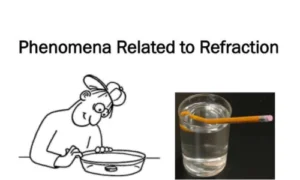
- Apparent Depth: Objects in water look closer than they are.
- Mirages: Optical illusions in deserts or hot roads caused by the refraction of light through air layers of different temperatures.
- Dispersion of Light: Splitting of white light into colours when it passes through a prism.
- Total Internal Reflection (TIR): When light reflects entirely inside a medium instead of refracting—used in optical fibres and diamonds.
Conclusion
Light and optics not only help us understand natural phenomena but also drive modern technology. From mirror reflections and water refraction to lenses in eyeglasses, telescopes that explore the universe, and microscopes that reveal the microscopic world—optics is everywhere. Refraction, too, is more than a classroom concept; it surrounds us in daily life, from rainbows and eyeglasses to telescopes and fibre-optic internet. Together, these principles connect the wonders of nature with the innovations that shape our future.
FAQs on Light & Optics
Q1. What is the difference between reflection and refraction?
Reflection is the bouncing back of light from a surface, while refraction is the bending of light when it enters a new medium.
Q2. Why do stars twinkle at night?
Stars twinkle because their light gets refracted multiple times while passing through the Earth’s atmosphere.
Q3. Which lens is used in magnifying glasses?
A convex lens is used in magnifying glasses to converge light rays and enlarge images.
Q4. How is a telescope different from a microscope?
A telescope is used to observe distant objects like stars and planets, while a microscope is used to magnify very small objects like cells and bacteria.
Q5. What are some daily life examples of lenses?
Spectacles, cameras, magnifying glasses, projectors, and binoculars all use lenses.


